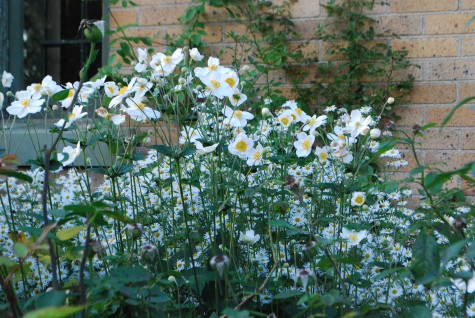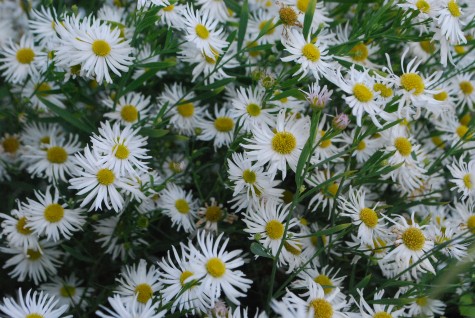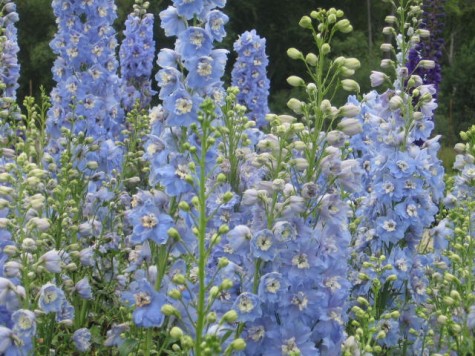 Some gardeners have to pick there moments. A spring wildflower and bulb garden highlighted by hellebores, perhaps. Or an early summer rose and delphinium fest. Does a late summer garden suit you better? Are your pots your passion? If I were retired, had a garden the size of Sissinghurst, and an garden staff, I might could have it all. But that is not the case. I work every week that the garden is in session.
Some gardeners have to pick there moments. A spring wildflower and bulb garden highlighted by hellebores, perhaps. Or an early summer rose and delphinium fest. Does a late summer garden suit you better? Are your pots your passion? If I were retired, had a garden the size of Sissinghurst, and an garden staff, I might could have it all. But that is not the case. I work every week that the garden is in session.
 I am utterly focused on the work at hand from early May until the 4th of July. This means I have little time to enjoy and nurture a garden at home. People in the nursery business or the landscape business all have the same issues. They get to work early; they go home late. They work the weekends too. Once the early spring has passed, and the magnolias are finished blooming, my eyes and hands are everywhere but at home enjoying my garden.
I am utterly focused on the work at hand from early May until the 4th of July. This means I have little time to enjoy and nurture a garden at home. People in the nursery business or the landscape business all have the same issues. They get to work early; they go home late. They work the weekends too. Once the early spring has passed, and the magnolias are finished blooming, my eyes and hands are everywhere but at home enjoying my garden.
 I plant lots of pots-this keeps my love of gardening alive while my attention is elsewhere. When I come home at night and water, I feel like I am gardening. My landscape is designed around my lack of time to pay attention. I have lots of mature evergreens that require little but a once yearly pruning, and some thoughtful watering. Late in August, I start to come up for air. I am looking at my gardens.
I plant lots of pots-this keeps my love of gardening alive while my attention is elsewhere. When I come home at night and water, I feel like I am gardening. My landscape is designed around my lack of time to pay attention. I have lots of mature evergreens that require little but a once yearly pruning, and some thoughtful watering. Late in August, I start to come up for air. I am looking at my gardens.
 The late blooming perennials I greatly enjoy, as I have time to enjoy them. My rose garden is underplanted with white Japanse anemones, and boltonia. Boltonia is a selected native fall blooming aster that is one of my favorite plants. They grow all summer long without one bit of encouragement from me, and bloom like there is no tomorrow in September. They are not fussy in any way, beyond appreciating regular water. Bugs and disease-they are impervious. For the past 3 weeks, I have been looking at these tall growing clumps out my south side windows. How they thrive makes me look like a good gardener.
The late blooming perennials I greatly enjoy, as I have time to enjoy them. My rose garden is underplanted with white Japanse anemones, and boltonia. Boltonia is a selected native fall blooming aster that is one of my favorite plants. They grow all summer long without one bit of encouragement from me, and bloom like there is no tomorrow in September. They are not fussy in any way, beyond appreciating regular water. Bugs and disease-they are impervious. For the past 3 weeks, I have been looking at these tall growing clumps out my south side windows. How they thrive makes me look like a good gardener.
 The white Japanese anemones thrive equally well-on the south side of my house, in between and behind the roses. They have no problem with a full sun location. I do water my roses regularly via drip irrigation-the anemones seem to appreciate it. For the better part of 10 days I have been wading into the anemones and boltonia with my camera. I have time to look, and appreciate what is going on.
The white Japanese anemones thrive equally well-on the south side of my house, in between and behind the roses. They have no problem with a full sun location. I do water my roses regularly via drip irrigation-the anemones seem to appreciate it. For the better part of 10 days I have been wading into the anemones and boltonia with my camera. I have time to look, and appreciate what is going on.
 I do not have the means or space to mount and maintain a garden that is lovely every moment of the entire season. I have to make choices. I like a late and a later season garden. I like tall billowy perennials. This means I personally favor hyssop, monarda, boltonia, hardy hibiscus, Joe Pye weed, ornamental grasses. aging Russian sage, phlox paniculata, lespideza, asters, anemone Japonica, among others. This has every bit as much to do with my availability, as their form and flowers. There are very few garden plants I do not like. I would have them all, if I could.
I do not have the means or space to mount and maintain a garden that is lovely every moment of the entire season. I have to make choices. I like a late and a later season garden. I like tall billowy perennials. This means I personally favor hyssop, monarda, boltonia, hardy hibiscus, Joe Pye weed, ornamental grasses. aging Russian sage, phlox paniculata, lespideza, asters, anemone Japonica, among others. This has every bit as much to do with my availability, as their form and flowers. There are very few garden plants I do not like. I would have them all, if I could.

But there are those plants that get special care and attention, as their time to be corresponds with my time to give. The big late blooming perennials-they occupy a special place in my gardening heart. As for your garden, I would make this suggestion. Choose the season that delights you the most-and go for broke. If you want to grow great vegetables, organize your gardening efforts accordingly, and make plans for rocking pots of basil. If you have a summer house elsewhere, make spring your season. If you are a working person, plan for a glorious garden when you are the least busy.
Trying to be all things at all times sounds way too much like a competition. A great garden that engages and satisfies an individual gardener is all about enabling a certain quality of life. Those astonishingly beautiful pictures you see of gardens in magazines-they are all about a specific moment chosen by a gardener. Choose your moment.










